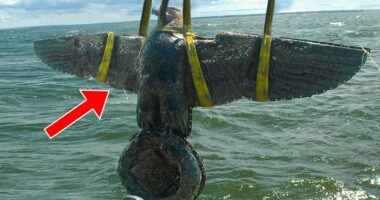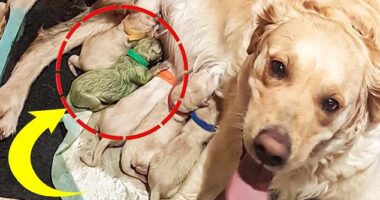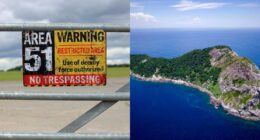Jake Callahan had always been drawn to the cold, vast landscapes of the Arctic. As a wildlife photographer and adventurer, he had traveled to some of the most remote locations on Earth. But nothing could have prepared him for what he encountered on a solo expedition to the frozen wilderness of Canada’s Arctic Archipelago.
The plan was simple: spend a week documenting the stark beauty of the ice-covered terrain, capturing rare shots of Arctic wildlife in its natural habitat. With his camera gear packed and provisions stocked, Jake set out alone on his snowmobile, determined to document the icy solitude. He had expected silence, the endless white stretching in every direction. What he had not expected was to find himself face-to-face with the Arctic’s most fearsome predator—a polar bear.
The Silence of the Frozen World
The first few days were uneventful, with Jake navigating the tundra, setting up camp in different locations, and capturing images of the occasional Arctic fox or a flock of snow buntings. The air was crisp, and the only sounds he heard were the crunching of his boots on the ice and the occasional howling wind.
One morning, as he stepped out of his tent with his camera slung around his neck, something felt different. A strange stillness had settled over the ice. He scanned the horizon, searching for movement. The Arctic was unpredictable, and while Jake had trained for harsh conditions, there was always an underlying unease about being so far from civilization.
He was about to dismiss the eerie silence and go about his morning routine when he noticed something—a faint but unmistakable indentation in the snow. Tracks. Large ones. His heart pounded. He knelt, running his gloved hand over the frozen imprint. They were fresh.
The First Glimpse
Jake stood up and turned slowly, scanning the ice. At first, there was nothing but white. Then, just beyond a ridge of ice, a shape moved.
A polar bear.
The bear was massive, its thick white fur blending seamlessly into the surroundings. It stood on all fours, its head slightly lowered, watching Jake with dark, intelligent eyes. Jake knew that polar bears were the apex predators of the Arctic. Unlike other bears, they were not afraid of humans—and they were known to be relentless hunters.
Adrenaline surged through his veins. He had read countless stories about polar bear encounters, some ending in awe-inspiring escapes, others in tragedy. He reached for his camera instinctively, his fingers fumbling with the cold metal. If he was going to have a run-in with one of nature’s most formidable creatures, he would document it.
A Tense Standoff
Jake clicked the shutter, the camera’s sound barely audible against the Arctic wind. The bear’s ears twitched at the noise, but it didn’t move. For several minutes, neither Jake nor the bear shifted. It was a standoff, each assessing the other.
His survival training kicked in. Running was out of the question—polar bears could outrun a human in seconds. Climbing was also impossible—there were no trees, no structures, nothing but ice. The only thing he could do was remain calm, keep eye contact, and slowly back away toward his tent and snowmobile.
The bear exhaled, a visible cloud of breath forming in the freezing air. Then, it took a step forward.
Jake swallowed hard. He resisted the urge to turn and flee. He knew the bear wasn’t just curious; it was deciding whether he was food. He reached into his pocket, feeling for the flare gun he always carried for emergencies. If it came too close, he would have to fire it and hope the bright, crackling light would deter the predator.
A Moment of Understanding
Then something unexpected happened. The bear stopped. It sniffed the air, tilted its head slightly, and sat back on its haunches.
Jake, still gripping his flare gun, was bewildered. The bear wasn’t attacking. It wasn’t even advancing anymore. Instead, it simply observed him, as if deciding whether this strange, two-legged creature was worth the effort.
He slowly lifted his camera again. This time, he focused on the bear’s face—the deep-set black eyes, the powerful snout, the scars that told of battles won and lost. He captured shot after shot, each click feeling like a moment stolen from the wild.
For what felt like an eternity, the two shared the ice. Man and beast, predator and potential prey. But then, as suddenly as it had appeared, the bear rose, gave one last look at Jake, and padded away toward the distant ice floes.
The Aftermath
Jake stood frozen, his breath coming in sharp bursts. Had he just been spared? Had the bear lost interest, or had it sensed something about him that made it decide against an attack? He would never know.
As the bear disappeared into the distance, Jake felt a profound sense of respect and gratitude. He had come to the Arctic seeking to capture its untamed beauty, and in the process, he had experienced something few ever would—a moment of connection with one of the most powerful creatures on Earth.
That night, he uploaded the photos onto his laptop, each image a testament to the encounter. The next day, he packed up his gear and began the journey back to civilization, forever changed by the silent, chilling presence of the great white bear.
Reflections on the Wild
Back home, Jake’s photographs of the polar bear encounter went viral. Experts analyzed the images, debating whether the bear had been hunting or merely curious. Some suggested that the bear, accustomed to human presence from scientific expeditions, may not have seen Jake as food. Others believed it had sensed his calm demeanor and chosen not to engage.
Jake’s experience didn’t just gain popularity among wildlife enthusiasts; it also sparked discussions about the fragile ecosystem of the Arctic. Scientists and conservationists used his images to highlight the impact of climate change on polar bears, whose hunting grounds are rapidly shrinking due to melting ice caps.
Realizing that his close call could have been much worse had the circumstances been different, Jake took a new approach to his work. He began advocating for Arctic conservation, partnering with organizations that aimed to protect the fragile habitat of polar bears. His breathtaking images, once meant only for his portfolio, became powerful tools in the fight against climate change.
Jake returned to the Arctic several times over the years, each time more prepared and respectful of the land that had nearly taken his life. But never again did he have such a close, intimate encounter with a polar bear. That one moment—locked in a silent standoff with one of nature’s greatest hunters—remained the most profound experience of his life.
The Arctic was a world of both beauty and danger, and Jake had witnessed its raw power firsthand. He knew that his story was more than just an adventure; it was a testament to the delicate balance between human beings and the natural world. A balance that, if not carefully maintained, could disappear forever.
For Jake, the lesson was clear—respect the wild, and it might just respect you in return.







